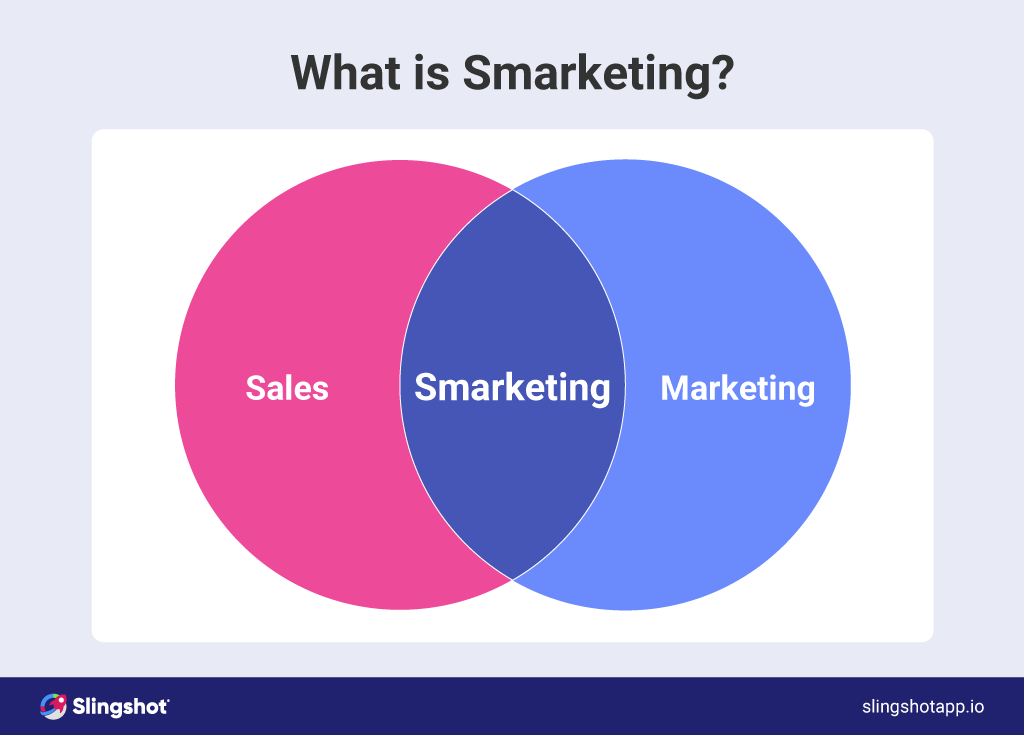Marketing, which supplies leads, and sales, which converts leads into opportunities and ultimately orders, each play different roles. For this reason, marketing and sales tend to have an adversarial relationship, but the goal of both should be to contribute to sales. This time, we will introduce key points for cooperation between marketing and sales to maximize sales.
Smarketing where marketing and sales work together
The collaboration between marketing and sales is called Smarketing. It is a coined word that combines marketing and sales.
Marketing and sales essentially have the same goal of achieving sales, and each fulfills their own role. Marketing takes all kinds of measures to target companies to acquire prospective customers, while sales conducts business negotiations with prospective customers and leads to orders through communication.
Without prospective customers, sales staff cannot conduct business negotiations, and marketing efforts are meaningless if orders cannot be won. Collaboration between marketing and sales is essential to maximizing sales.

Benefits of smarketing
There are three benefits of marketing:

① Leverage your marketing and sales strengths
Due to the nature of marketing work, a lot of work is done on computers, and analysis is the main focus, and the results and insights obtained from analysis can be utilized in sales activities. However, compared to sales, there are fewer points of contact with customers, and customer resolution tends to be lower.
Sales, which have frequent contact with customers, have a high level of understanding of customers, and by regularly sharing customer information such as needs for products and services with marketing, marketing can improve customer resolution.
By leveraging the strengths of both parties in marketing and sales activities, you can increase the number of prospective customers and increase the rate of business negotiations.

② Increased work efficiency
To begin with, marketing and sales are separated in order to maximize sales. Marketing focuses on acquiring and nurturing potential customers, and sales focuses on creating and closing projects.
If the collaboration between marketing and sales is strengthened, there will be no need for unnecessary information gathering and communication, allowing them to focus on their respective tasks, leading to increased operational efficiency.

③ New ideas are encouraged and the improvement cycle is accelerated.
Attributes such as the customer’s business type and company size, as well as business card information such as the department, name, and contact information of the person in charge, flow from marketing to sales. Opportunity information flows from sales to marketing.
If marketing and sales work together smoothly, information sharing will also be smooth. As a result, marketing can maintain an up-to-date customer image and immediately reflect it in measures.

Marketing and sales collaboration points
Here are five points to help marketing and sales work together.

① Create a common persona and customer journey
We often hear from sales people that the prospective customers our marketing team acquired were not the target companies for our products or services at all. This may be due to marketing not knowing the correct target customer.
To prevent this from happening, create common personas and customer journeys for marketing and sales. Sharing the same persona not only prevents misalignment of target customers, but also facilitates conversations between both parties regarding prospects.

② Formulate SLA
SLA is an abbreviation for Service Level Agreement, which clearly states what marketing and sales must accomplish in order to reach the final goal, such as receiving an order or contract. In other words, it is a contract between marketing and sales.
Specifically, it includes the following items:
- Conditions for prospective customers passed from marketing to sales
- Follow-up conditions such as the frequency and timing of approaches to the given prospective customers, etc.
By formulating an SLA, you can clarify the contribution of each party to the goal and use it as a tool to check each other’s performance.

③ Manage with a common goal
Set common sales goals for marketing and sales, and design KPIs for each from there. By having a common goal, you can check the effectiveness of marketing measures, and by managing prospects passed to sales in a pipeline, you can check progress toward sales targets.

④Introduce common tools
By introducing common tools (CRM tools and SFA tools), you can smoothly manage the effectiveness of marketing measures and pipeline management. You can also create a dashboard within the tool and check the progress of your goals.
Choose the tools that suit your company. Additionally, an operational design is required to ensure that the system can be used properly even after it has been introduced.

⑤ Increase the frequency of communication
Increase communication and strengthen collaboration between marketing and sales. Particularly in marketing, by receiving feedback from sales staff about past measures and prospective customers, you can improve your customer experience and improve your measures.
It is also more effective to share business processes so that marketing and sales can speak a common language, have marketing members participate in sales negotiations, and improve the quality of communication.

summary
- The collaboration between marketing and sales is called smarketing, and collaboration between marketing and sales is essential for maximizing sales, which is the common goal of both.
- There are three benefits of marketing: (1) it leverages the strengths of marketing and sales, (2) it improves operational efficiency, and (3) it promotes new ideas and speeds up the improvement cycle.
- Sharing the same persona for marketing and sales coordination not only prevents misalignment of target customers but also facilitates conversations about prospects.
- SLA is an abbreviation for Service Level Agreement, which clearly states what marketing and sales must accomplish in order to reach the final goal, such as receiving an order or contract. By formulating an SLA, it becomes a tool to clarify the contribution to each goal and check each other’s performance.

